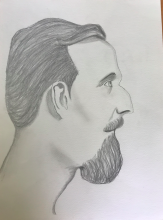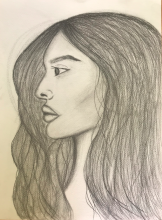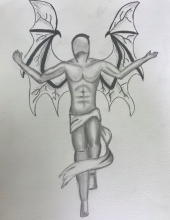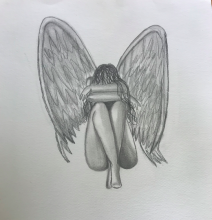My project was inspired by the gender dynamic present in troubadour poems and songs. While the cantos are often romantic and tell tales of far-away love that burns ardently or forbidden love that seems so close, yet so far, it is prevalent that the love between men and women is a main theme of troubadour songs. With that in mind, examining the songs of both the Comtessa the Dia and of (male) troubadours allowed for different perspectives on the songs with fin-amor themes. Specifically, my project focuses on the idea of the male gaze, a concept first introduced in film to describe the way male direction of movies leads to male centered perspectives that can oftentimes commodify, objectify, and fetishize women. I found a similar pattern with troubadour poems. By analyzing the male gaze in troubadour poems, I aim to take into account the lost female perspective that was not in incorporated in many troubadour songs.
The drawings of the man and woman are meant to be facing eachother, and the pieces function in 2 pairs. The two people facing each other represent this male gaze often given by troubadours in their songs, while also representing the gaze of the trobaritz who also used the fin-amor theme, but in different ways. The drawing of the female angel and the male demon represent the gender dichotomy that aims to allow for more analysis of the differing male and female perspective of troubadour song. Aside from this, it also incorporates the often-religious themes of troubadour songs that allow for the songs of troubadours or be explicitly impactful to the audience of the time. The woman is here represented as averting the male gaze and power through her stance, where the man’s stance conveys power using the religious motif of lifted hands.




